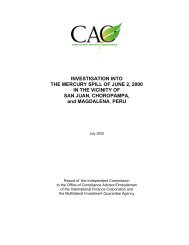A Guide to Designing and Implementing Grievance Mechanisms for ...
A Guide to Designing and Implementing Grievance Mechanisms for ...
A Guide to Designing and Implementing Grievance Mechanisms for ...
You also want an ePaper? Increase the reach of your titles
YUMPU automatically turns print PDFs into web optimized ePapers that Google loves.
Foreword<br />
<strong>Grievance</strong> mechanisms are increasingly important <strong>for</strong> development projects where ongoing<br />
risks or adverse impacts are anticipated. They serve as a way <strong>to</strong> meet requirements, prevent <strong>and</strong><br />
address community concerns, reduce risk, <strong>and</strong> assist larger processes that create positive social<br />
change. Today, many companies employ ad hoc or exclusively internal processes <strong>to</strong> address<br />
grievances. Un<strong>for</strong>tunately, these systems often produce less than satisfac<strong>to</strong>ry outcomes from<br />
the perspective of the company <strong>and</strong>/or the community. Recognizing this, <strong>and</strong> noting a lack of<br />
effective alternatives, companies <strong>and</strong> communities are becoming more proactive in their ef<strong>for</strong>ts<br />
<strong>to</strong> design <strong>and</strong> build more effective strategies <strong>for</strong> addressing community grievances.<br />
Yet it is often challenging <strong>for</strong> companies <strong>to</strong> design <strong>and</strong> implement successful grievance<br />
mechanisms that suit the project context. Recognizing the challenge, the Office of the<br />
Compliance/Advisor Ombudsman (CAO) offers this guide <strong>to</strong> help groups develop project-level<br />
grievance resolution mechanisms. This guide also emphasizes the importance of<br />
communication <strong>and</strong> coordination among companies, communities, <strong>and</strong> other stakeholders<br />
directly affected by large development projects. We have learned from many years of<br />
experience that open dialogue <strong>and</strong> collaborative grievance resolution simply represents good<br />
business practice—both in managing <strong>for</strong> social <strong>and</strong> environmental risk <strong>and</strong> in furthering<br />
company <strong>and</strong> community development objectives.<br />
This guide is offered as a companion <strong>to</strong> Per<strong>for</strong>mance St<strong>and</strong>ards <strong>and</strong> accompanying Guidance<br />
Notes published by the International Finance Corporation (IFC) <strong>and</strong> Multilateral Investment<br />
Guarantee Agency (MIGA) of the World Bank Group. These st<strong>and</strong>ards set <strong>for</strong>th a role <strong>for</strong><br />
grievance mechanisms <strong>for</strong> projects financed or assisted by IFC <strong>and</strong> MIGA.<br />
Against the backdrop of the IFC <strong>and</strong> MIGA Per<strong>for</strong>mance St<strong>and</strong>ards, this guide consolidates<br />
knowledge <strong>and</strong> lessons regarding grievance resolution from various sources, including on-theground<br />
experiences of the CAO, findings from studies on grievance resolution in the workplace<br />
<strong>and</strong> in environmental conflict resolution, <strong>and</strong> from practical experience in establishing peace<br />
accords <strong>and</strong> procedures in postconflict disputes over l<strong>and</strong> <strong>and</strong> property. Our methodology also<br />
included an extensive review of existing in<strong>for</strong>mation on grievance mechanisms from the field of<br />
conflict resolution.<br />
In addition, we obtained first-h<strong>and</strong> accounts through interviews with industry personnel,<br />
academics, nongovernmental organizations (NGOs), international financial institutions,<br />
consultants, <strong>and</strong> others with experience of grievance mechanisms. These interviews focused on<br />
the challenges involved in designing <strong>and</strong> implementing grievance mechanisms <strong>and</strong> the practical<br />
strategies <strong>and</strong> steps required <strong>for</strong> an effective system, regardless of its <strong>for</strong>m.<br />
As grievance resolution mechanisms are increasingly adopted, companies <strong>and</strong> communities<br />
must learn how <strong>to</strong> design <strong>and</strong> implement these systems cooperatively <strong>and</strong> more effectively<br />
<strong>for</strong> their potential <strong>to</strong> be realized. We hope this guide will equip people interested in initiating<br />
a grievance resolution program with the practical steps <strong>and</strong> <strong>to</strong>ols they need <strong>to</strong> be successful<br />
in ef<strong>for</strong>ts <strong>to</strong> address community concerns <strong>and</strong> promote improved relationships, fair remedies,<br />
<strong>and</strong> just procedures.<br />
Meg Taylor<br />
Vice President, Compliance Advisor/Ombudsman, CAO<br />
June 2008<br />
v





